Hoodies, as one of the classics of the fashion industry, has different fabrics, which not only affect the appearance and style, but also directly relate to the comfort and the ability to adapt to different seasons. In the following introduction, we will delve into several common hoodie fabrics, revealing their characteristics, advantages and application scenarios. Whether you are a fashion enthusiast, outdoor enthusiast or a person who attaches great importance to comfort, I believe that through this introduction you will have a sufficient understanding of hoodie fabrics, and know that according to the characteristics of fabrics to choose fabrics, make and choose the ideal hoodie!
Table of Contents
Clothing Common Clothing Fabric Knowledge Introduction
1.Hoodie Fabric Material:French Terry

French Terry is a kind of knitted fabric, also called fish scale fabric, which has single-sided and double-sided loops. During weaving, some yarns appear in the form of coils on other yarns of the fabric in a certain proportion and stay on the surface of the fabric, so it is called loop fabric.
Pros:
French Terry is relatively thick and has good warmth retention. Its good elasticity allows the fabric to quickly recover after deformation. In addition, the french terry also has good moisture absorption performance. It is breathable and comfortable for wearing, and can be used to make casual clothes, pajamas, and other clothing. The most common fabric for hoodie is french terry.
Cons:
The disadvantage is mainly based on the selection of raw materials. For example, french terry made of polyester yarn is not as breathable and comfortable as cotton yarn, but has better wear resistance and dimensional stability than french terry made of cotton yarn. Therefore, we need to choose the raw materials of french terry according to the useful scenarios of the fabric.
Ingredients: 75%-100% cotton (probability of pilling is relatively low)
Gsm weight :180Gsm-600Gsm
2. Hoodie Fabric Material:Chief Value Cotton (CVC)

Also known as healthy cotton hoodie (CVC), it uses the same weaving method both inside and outside. The texture is delicate and clear, with pearl mesh and strong texture. The fabric is slightly elastic and does not change shape, making the finished garment neat and stylish. Both sides can be made as the front, with a casual, trendy, and retro style. The texture is delicate, not easily pilling and fading, has a full and thick feel, is wear-resistant and wrinkle resistant, and has strong practicality.
Composition: The cotton content is between 30% -60%, while the rest is made of artificial fibers. Applicable season: autumn and winter Weight: 280G-380G
Advantages: delicate and smooth texture, compact texture, good elasticity, and not easy to shrink
Disadvantages: It is difficult to wash and is prone to pilling.
3.Hoodie Fabric Material: Fleece
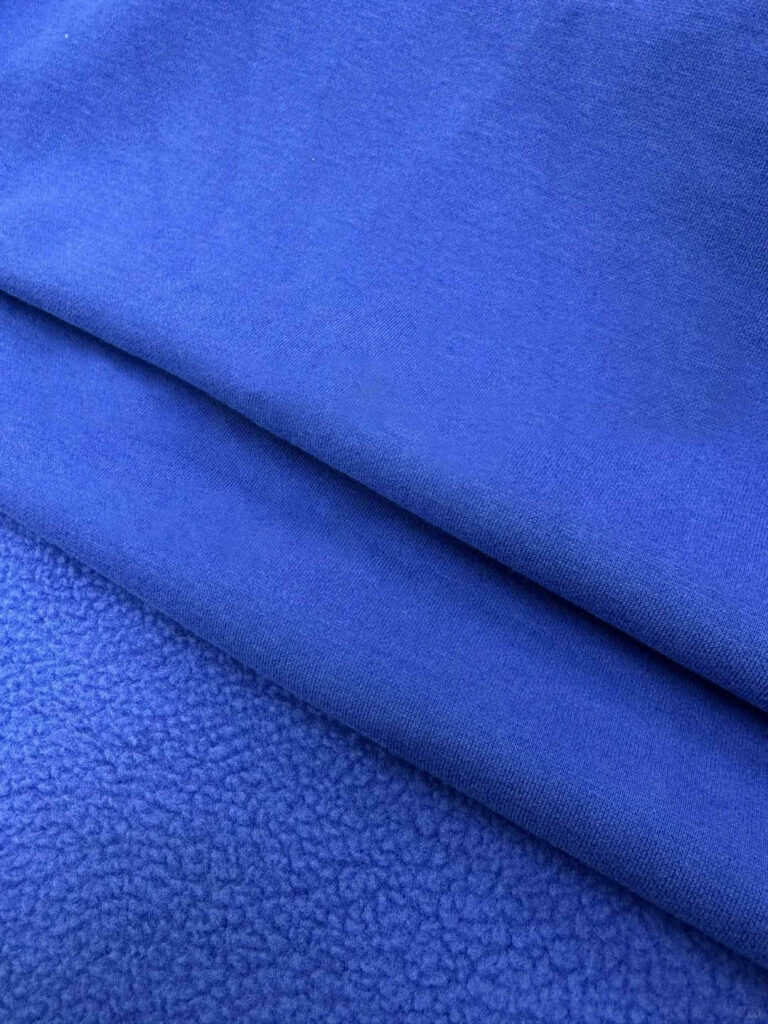
Fleece fabric refers to the process of sanding and combing the fabric to create a short layer of fleece on the surface.
This type of fabric is usually mainly made of polyester and polyester cotton blended, with very few pure cotton because pure cotton is not easy to pile up.
Due to the different methods and materials of fleece formation, there are a variety of fleece fabrics available. Due to different functions, it is mainly divided into insulation and windproof.
Fleece fabric has good insulation performance, which can effectively keep the body warm. Secondly, it is soft and comfortable, without irritating the skin. The fleece fabric also has the advantages of being lightweight and easy to carry, making it very suitable for outdoor activities. Finally, fleece has good breathability, which can effectively eliminate sweat and keep you dry.
Compared to regular hoodies, there is plush on the inside.
Ingredients: The cotton content is between 60% -100%, while the rest is made of artificial fibers.
Applicable seasons: late autumn and winter
Weight: 320G-460G
Advantages: Good warmth retention, thicker and softer fabric, sweat wicking and breathable. Disadvantages: Easy to shrink, slight shedding of hair, not recommended for single wear, requiring an inner layer as a base.
4 .Hoodie Fabric Material:Polar Fleece hoodie
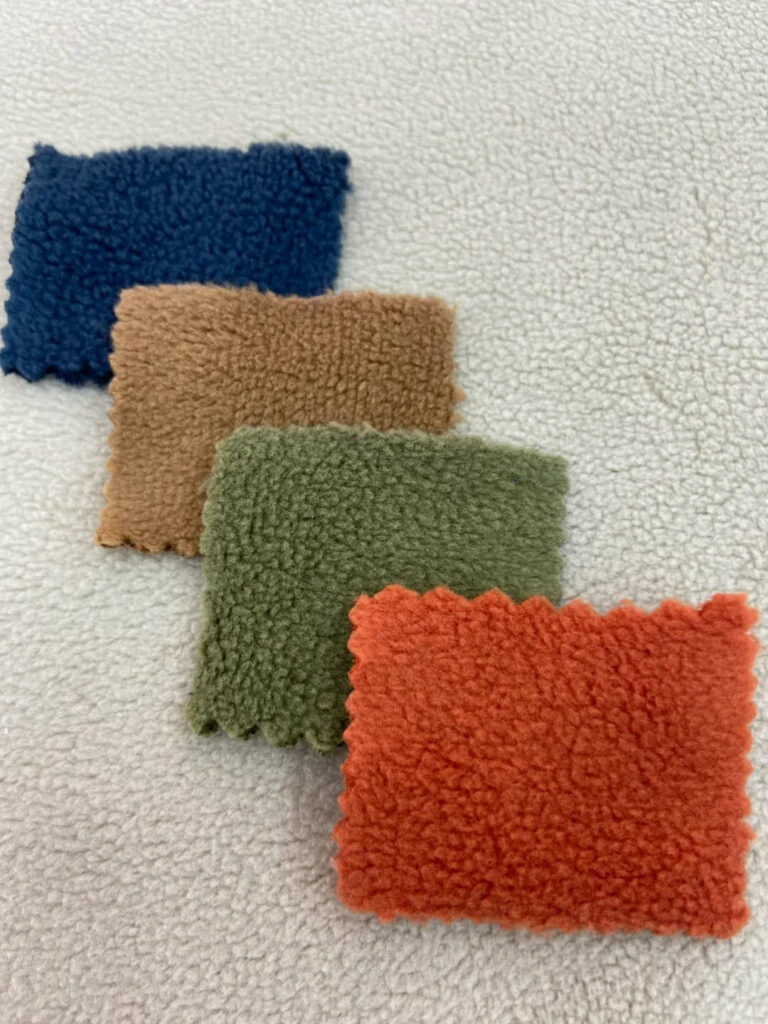
Polar fleece is a polyester knitted fabric woven by a large circular machine, which is first woven into raw fabric and then processed by various complex processes such as dyeing, drawing, combing, shearing, and shaking.
Advantages:
Soft feel, with fluffy dense, good elasticity, not easy to hair, not easy to pilling, cold resistance, flame retardant, anti-static and other advantages.
Cons:
The price is relatively high, and the quality of the products on the market is uneven, so there may be inferior fabrics.
Polar fleece can be combined with any other fabric to make the cold protection effect better.
For example: polar fleece and polar fleece composite, polar fleece and denim composite, polar fleece and lamb composite, polar fleece and mesh fabric composite with waterproof breathable film and so on.
Polar fleece is widely used, can be made into bedding, carpets, coats, jackets, vests, windbreakers, cheerleading team logo, cashmere gloves, scarves, hats, throw pillows, cushions and so on.
Composition: Cotton content between 30%-50%, the other is man-made fiber. Gram weight :400G-480G
Advantages: Feel soft and thick, skin delicate, warm hair.
Disadvantages: low sweat absorption effect, easy to wear for a long time.
5.Hoodie Fabric Material: Silver fox fleece hoodie

Silver fox velvet is a type of warp knitted ultra soft fabric, also known as mink velvet or island velvet. Its main components are polyester and spandex.
The silver fox suede material has a delicate texture, a soft touch, and is not easy to fuzz or fade. It also has good performance in strength and wear resistance, making it easy to maintain. The fabric has excellent elasticity, so it can quickly recover without wrinkles after being pulled or deformed.
Silver fox fur has a high density of fibers, making it suitable for making warm clothing and blankets for autumn and winter. And it has good breathability, can keep the human body dry, and is suitable for making casual clothing such as sportswear and home wear.
Ingredients: The main ingredients are polyester and spandex. Weight: 320G-480G
Advantages: Good elasticity, delicate texture, soft and comfortable, without pilling or fading. Disadvantages: A small amount of shedding, easy to generate static electricity, not very breathable.
6.Hoodie Fabric Material: Sherpa
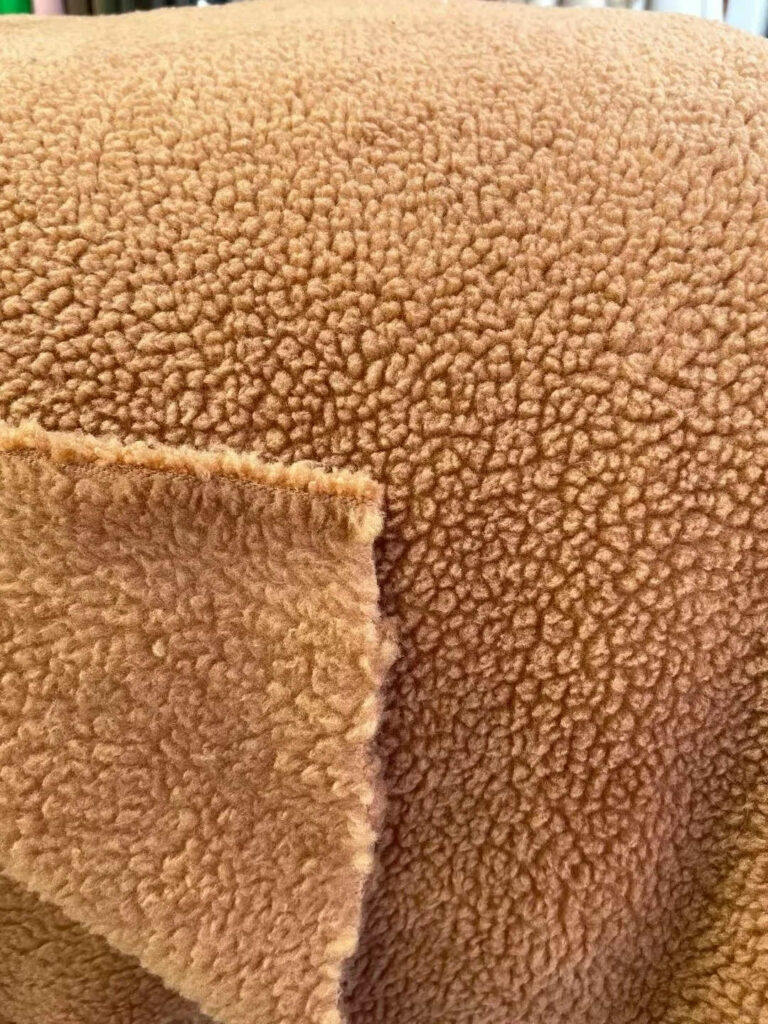
Sherpa is a type of synthetic fiber fabric, also known as artificial wool, due to its delicate and soft texture, like touching a small lamb.
Sherpa is a blend of polyester fiber and acrylic fiber, with a blending ratio of 70% and 30%. Generally, sherpa undergoes high-temperature shrinkage treatment, which is not easy to deform and wrinkle. When combined with other fabrics, it can achieve more functional and diverse clothing designs. Sherpa is often used in cold jackets, home clothes, hats, toys, decorative items, etc.
Ingredients: Polyester and acrylic blended. Weight: 400G-500G
Fabric advantages:
Good warmth retention, fluffy and breathable fabric, soft to the touch, not easily deformed or wrinkled.
The texture is soft and delicate, and the breathability is also good.
After high-temperature water washing, it is not easy to deform and will not wrinkle.
Good wear resistance, high tensile strength and elasticity, and long service life.
It does not produce insects and has good antibacterial effects.
Disadvantages: Wearing bulky clothes, lacking fashion sense, and prone to static electricity.
7.Hoodie Fabric Material: Long Plush hoodie
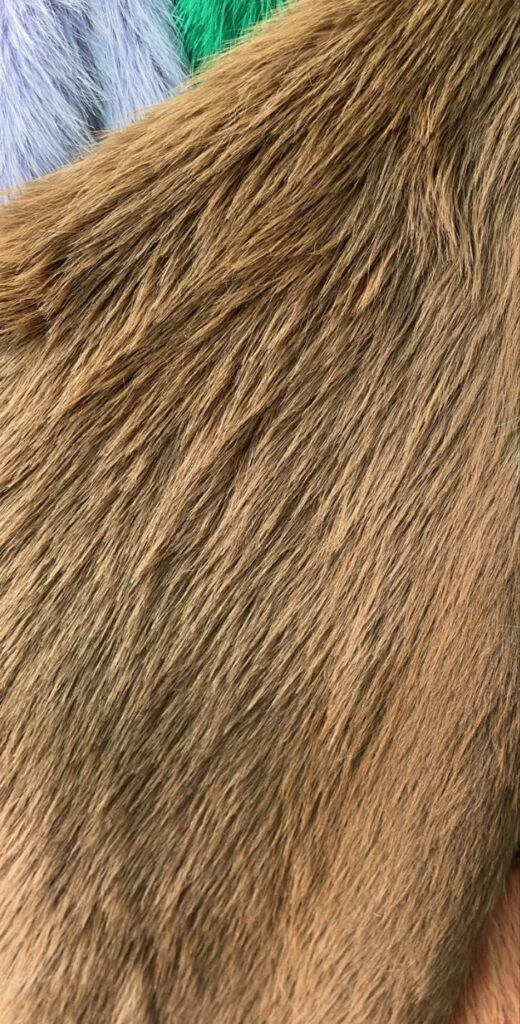
A standing plush fabric with a raised surface and a fur like appearance, commonly known as “sea tiger velvet”. The front is evenly covered with dense wool fibers, with a full and smooth velvet surface, rich in fat and elasticity, and good insulation performance. Mainly used for making coats, linings, collars, winter hats, plush toys, and can also be used for indoor decoration and industrial purposes. Long plush ground warp and weft are both made of cotton yarn; Woolen warp yarn is made of worsted wool yarn or synthetic fiber yarn. Two sets of cotton yarn, ground warp and ground weft, are interwoven in plain weave to form two layers of base fabric, with a raised yarn connected between the upper and lower layers of base fabric, woven into a double-layer pile.
The double-layer plush fabric is cut open by a slitting machine blade to form two pieces of long plush fabric. Then, the plush yarn is twisted and combed into fluffy single fibers by a long plush carding machine. The surface of the plush fibers is cut flat by a shearing machine, resulting in a plain colored long plush fabric. Solid colored plush can also be processed through screen printing, steam fixation, washing and desizing, dehydration and drying to produce printed plush with various animal skin patterns.
Applicable season: Winter Ingredients: mainly polyester Weight: 430G-500G
Features: Good warmth retention, wear-resistant and durable, not very soft to the touch, but not easily deformed. People with hair loss, lack of breathability, rhinitis, and asthma should avoid wearing it.
8.Hoodie Fabric Material: Non-fleece hoodie
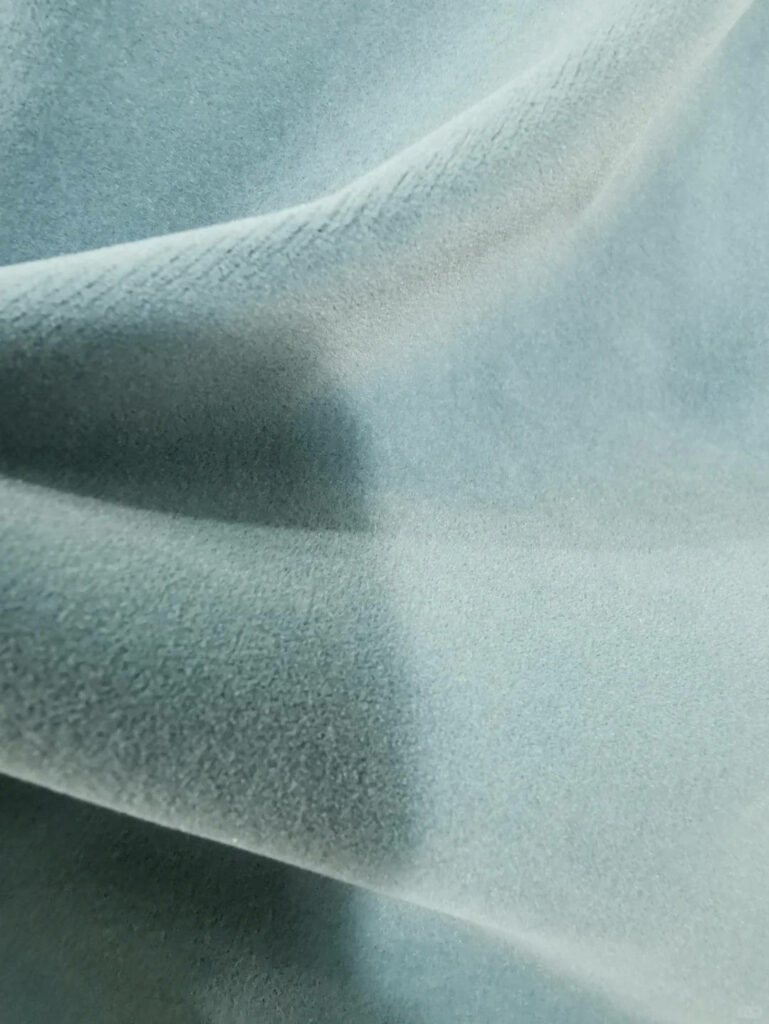
Non-fleece is a type of warp knitted elastic velvet.
The non-fleece is produced by using the front comb to make a long needle back cushion yarn movement on the surface of the fabric, using the elastic recovery force of spandex raw materials to form a wool circle on the surface, and cutting the long extension line during finishing to form a velvet surface.
We often use clothes made of non-fleece, such as the vast majority of thermal underwear is made of non-fleece. Non-fleece fabrics are commonly used to make clothes, shoes, household items, etc.
Composition :95% polyester +5% spandex Weight :400G-500G
Advantages of non-fleece fabric:
comfort
The non-fleece fabric is very soft and comfortable, which makes it ideal for making clothes, shoes, and household items. It also has good heat retention, which makes it ideal for winter wear.
Abrasion resistance
Non-fleece fabrics usually have good wear resistance, and its fluff can prevent wear and tear on the fabric surface, thereby extending the service life of the fabric.
Easy to clean
Non-lint fabrics are usually very easy to clean and can be washed by machine or hand washing.
Disadvantages: easy to stick hair, easy to generate static electricity.
Get In Touch
TUOZHEN with over 25 year clothing manufacturing experiences, providing one-stop private label custom knitted and woven garments service.Strearwear is not just clothes, it reflects a culture of individuality.
Warm welcome purchasing manager, individual clothing brand owners & designers, and wholesaler, ects. Email us your specific inquiries.
